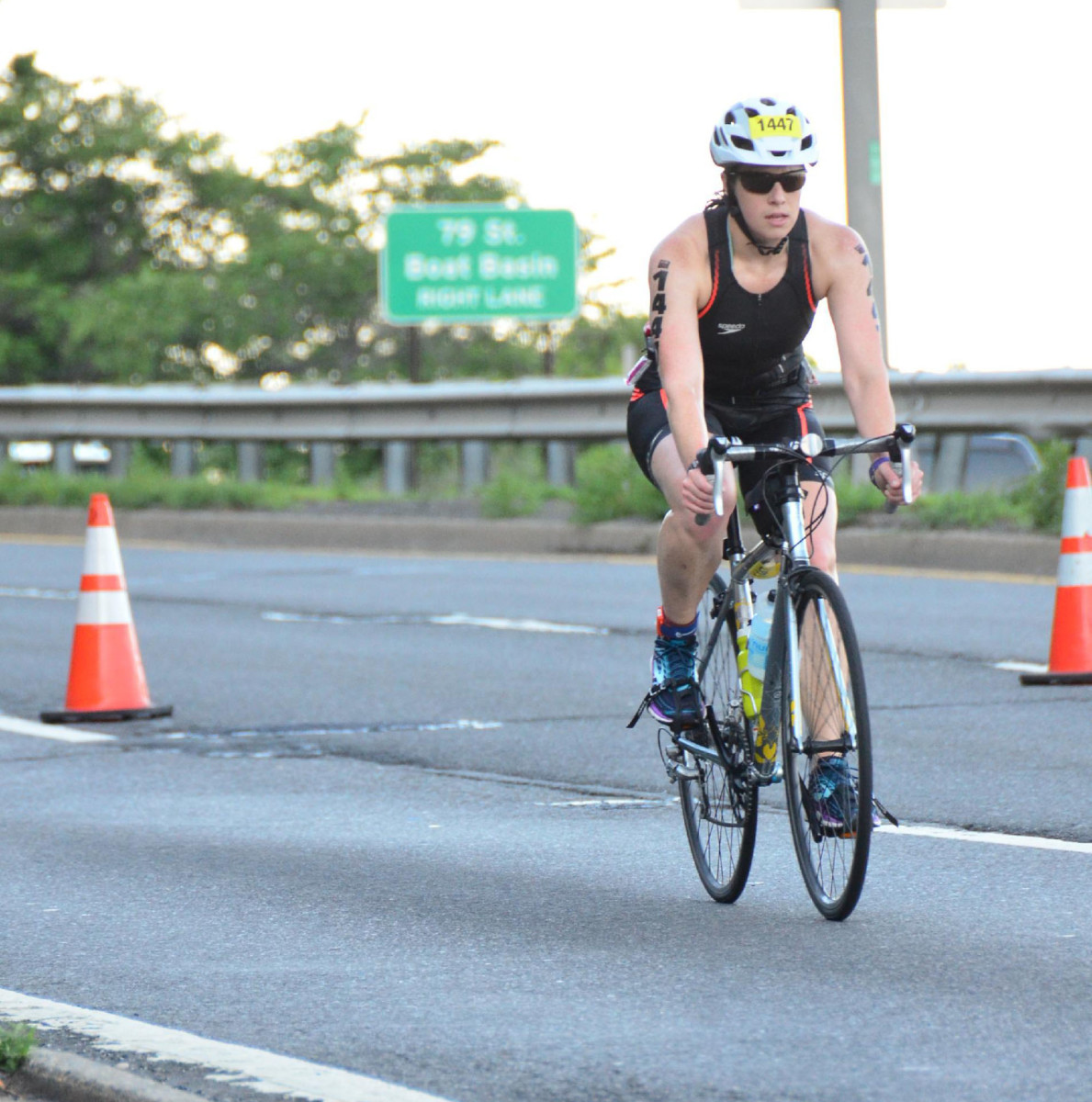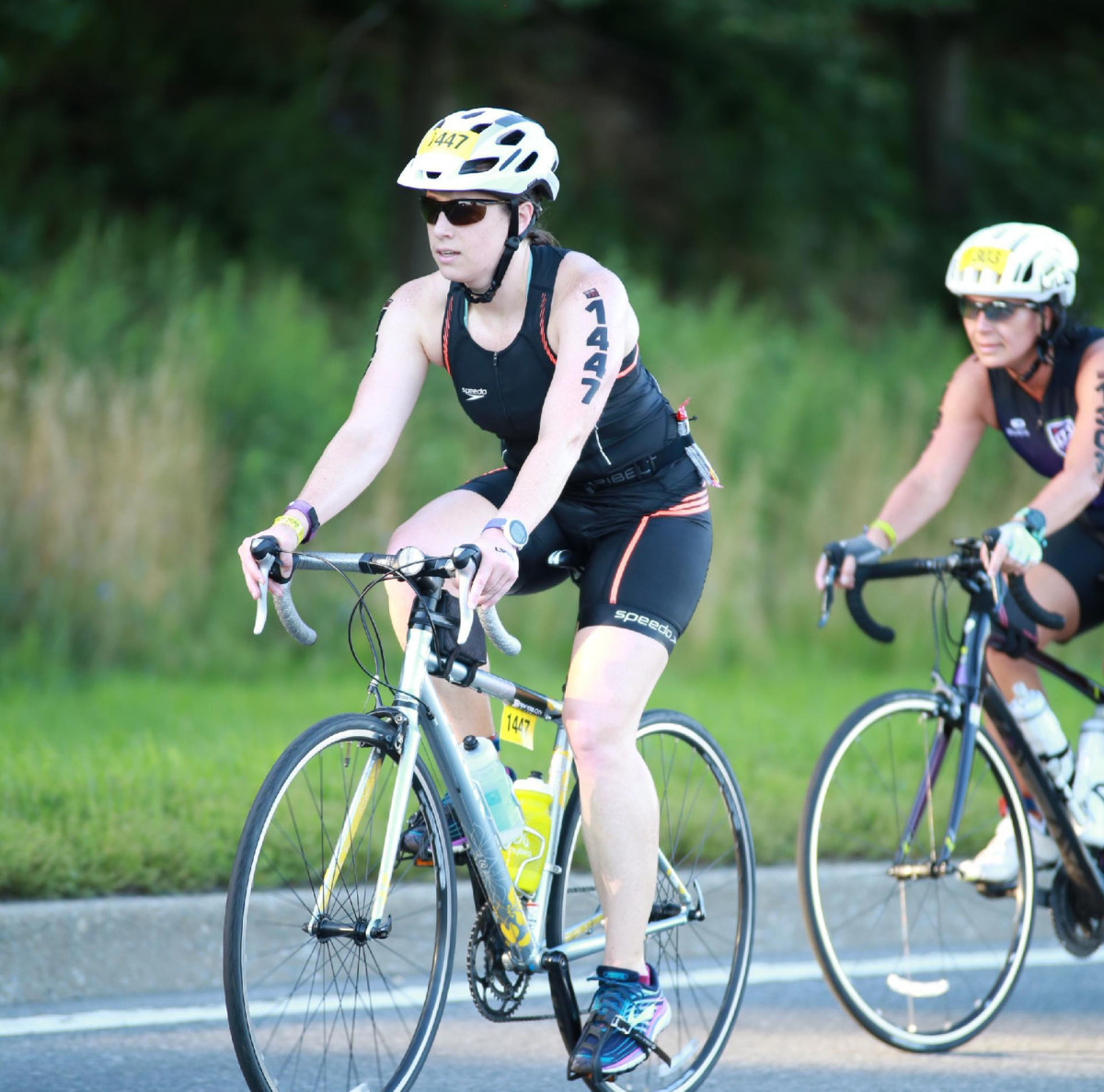What I Learned From My First Triathlon

After a 1500-meter swim in the Hudson River, a 40-kilometer bike ride up to Van Cortlandt Park and back, and a jog around Central Park (and, of course, two stops in the transition area at Riverside Park), I crossed the finish line of the NYC Triathlon in three hours, one minute and 27 seconds. And honestly, I could not have had a better experience.
I spent the day before the race running around Manhattan, hauling my bike on public transition before riding down 72nd street (and nearly getting hit by a cab) in order to check in at the transition area. By the time I was back home and resting, I was pretty pooped—and really didn’t have that much time to worry about what I was doing the next day. But I had plenty of fears heading into the NYC Tri—what if the heat was unbearable? What if I crashed or got a flat on the bike? What if I forgot to bring something crucial to transition?
Luckily, everything went off without a hitch. I was armed with plenty of information from Alex Isaly, a lead trainer at Life Time Fitness and my triathlon coach, but the entire race was still a complete learning experience for me. Here’s what I learned (...or didn’t learn) in my first triathlon.

Transitions get hectic! Set up your transition area neatly and plan ahead to only take what you absolutely need.
Anyone training for a triathlon learns early on that triathlons require quite a bit of equipment—it is a race which includes three different sports, after all. So it’s easy to be tempted to bring all of your gadgets, gears and gels.
“The key for the transition area is to make sure that you have it all set up the right way,” Isaly explained before the race. “I always take a towel and lay it out, put my cycle shoes together, and put my nutrition right there with my helmet and sunglasses. ...And when I come back to drop the bike, I have my running shoes, a hat and sunglasses right there besides my cycle stuff.”
I followed Isaly’s advice nearly to a T. I laid out my running shoes (I don’t have bike shoes, just cages), socks and a spare water bottle on a small towel next to my bike, and I threw everything else that I needed (sunglasses, sunscreen, GU Chomps, an extra Clif bar and my number belt) in my helmet that was clipped onto my bike handle. That way, when I frantically dashed into transition after the swim and had wriggled out of my wetsuit, I didn’t forget anything before embarking on the bike leg.
Before the race, Isaly told me that transitions can get frantic—and he definitely wasn’t lying. Gear ends up EVERYWHERE, and fellow athletes aren’t exactly moving slowly or carefully when it comes to getting bikes off the racks and to the mount line... My bike got tangled with the bike next to mine, and someone may or may not have stomped on my goggles that were lying on the ground. Shouts of “bike behind!” are constant, and the smell of sunscreen is unavoidable.
If allowed by the race, I recommend bringing a drawstring bag or something of the like where you can stuff your cap, goggles, wetsuit, sunscreen, whatever to keep your transition area organized. I tossed my wetsuit over the bike rack, which I’m not sure is allowed, and I felt really dumb when I had to mess with it before racking my bike after the bike leg.
Also, this is my place to remind you: no new gear on race day!
Deciding between no wetsuit or no wetsuit? Definitely wear a wetsuit (and don’t forget the BodyGlide!)
When I last checked in about a month ago, I was still trying to figure out what I should wear for the race. I chose to wear the Speedo tri kit (separate top and bottoms) for all three sports, and a Speedo full-body wetsuit for the swim leg. And I couldn’t have been happier with my decision (well, maybe if the shorts had large side pockets for easy access, but I digress).
I have to admit, I was hesitant to wear a full-body wetsuit off the bat. I have big shoulders and I get claustrophobic easily. How was I going to find one that fits correctly? What if I overheat? What if I can’t get it off? But I gave one a shot, and I couldn’t have been happier.
How to conquer the biggest challenges first-time triathletes face on race day
First off, you feel like a dang superhero while wearing the thing. It’s incredibly difficult to get on. Isaly told me rub BodyGlide anti-chafe balm, not Vaseline—the petroleum breaks down a wetsuit over time—all over my forearms and calves to ease the process of getting it on and off. It’s totally worth it once you’re in because you feel completely indestructible.
Cold water? A creepy-crawlie in the water? A fellow swimmer’s sharp nails? Nothing bothers you. To top it off, wetsuits increase your buoyancy, making the swim slightly faster. Just don’t forget the body glide, or else you might lose that time gained on the swim while trying to wrestle the suit off.
Learn. How. To. Sight. While. Swimming.
Not only should you learn the nuances of the swim course—is there a current? How many turns?—but you should really learn to keep your point as well. And I bet you can guess what happened to me... yep, I tried so hard to hug the outside of the swim course that I ended up swimming way off course, so much so that a boat honked at me, and the person on the boat yelled at a person in a kayak, telling them to do a better job of keeping swimmers on course.
Whoops.
And yes, those of you who have followed along from the beginning you will remember that learning how to sight was one of the first pieces of advice that Isaly gave me. But I didn’t practice it enough, and ended up swimming at least 300 extra meters. Live and learn...

Train for the bike on a course that resembles your race (as much as possible)
I said before that coming into this race, biking was the sport with which I was least familiar ... I didn’t even own a road bike until two months ago! But if there’s one thing that I recommend as a newbie triathlete, it’s that you should do at least a few rides on a course that resembles your racecourse. I had heard that the bike course was pretty hilly, but I also knew that it was an out-and-back... what goes up must come down and all that, right? Basically, I didn’t worry too much about the hills and figured I’d wing it.
Well, after training only on flat roads, I really regretted that mindset on the backside of the first hill that I climbed. I realized that not only did I not really know how to properly change gears, but I had no idea what to do when I was flying downhill at close to 30 miles an hour. At the bottom of a particularly big hill at one point, a woman passed me on my left and remarked, “Wasn’t that fun?!” I nodded my head and smiled back, but what she didn’t see were my knuckles, white from holding the handlebars in a death grip for the last hour.
Eat and drink as much as you can on the bike.
Get your nutrition down while you can, because if you’re depleted by the time you hit the run, there’s no coming back. Athletes usually find that the biking leg of a triathlon is generally the easiest time to focus on nutrition, so every athlete should aim to intake about 60 grams of carbohydrates during this leg. I went a little bit less and took two chomps every five miles, but I had tested that nutrition plan during a longer bike a few weeks earlier, and was pleased with the way I felt. I kept two Clif bars on me—one in my tire-patch kit on my bike and one tucked into the back pocket of my tri top—in case of emergency, but I never needed them! (The emergency came several hours after I finished, when I was craving a cookie, but a peanut butter banana-flavored Clif bar was the best I could get without leaving my couch.)
Data nerds—don’t be a slave to your watch during the run (or during the entire race, really).
I almost always train with a Garmin watch, but since the model that I have (Forerunner 220) doesn’t have a multisport option, I chose to not wear it during the swim—making it easier to get my wetsuit off!—and start it at the beginning of the bike.
Well, even the best-laid plans go awry, because I put my watch on in the first transition, but in the scramble to get out and get onto the bike, I forgot to start it. I estimated that I went probably a half-mile before remembering to start it, but for the most part, I didn’t look at it for the remainder of the race—and it was incredibly freeing! The only time I snuck a peek was when I was roaring downhill after a tough climb, and I wanted to note what my speed was (I nearly hit 30 miles an hour!).
Taking on the triathlon: A first-timer's quest to complete the swim, bike, run
When I racked my bike in the second transition, I took a few seconds to stop my watch and switch it over to the run function, but again, my timing wasn’t perfect. At that point, I simply decided to just run by feel, keep my legs moving and try to not walk at all on the run. I knew that looking at my watch every few minutes to track my pace would only stress me out, so I didn’t. Also, I had no idea what my overall time was, so I didn’t worry too much about it. Sure, if I was chasing a time goal, I might have made more of an effort to track my time, but today, I knew I was just out to give it my all and finish.
And I did exactly that, crossing the line in 3:01:27. Sure, maybe if I had known I was less than 90 seconds away from finishing under three hours, I would have hustled a little more. But everyone needs goals to chase, right?
